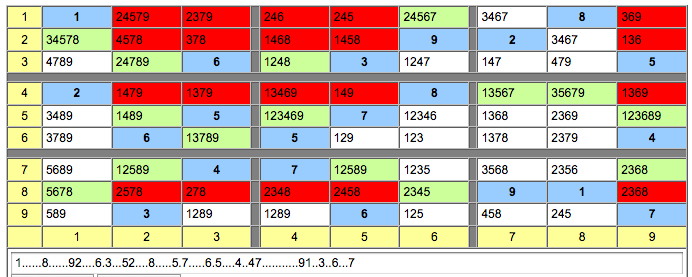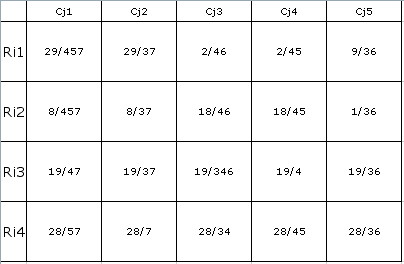Hi Robert,
Mauriès Robert wrote:However, I have difficulty seeing the relationship with Allan Parker's principles.
So I will read the writings of David Bird and Allan Parker to try to understand.
I can't help with your problem directly, but I can give some simple examples of set logic to support your studies. I'll use similar simple examples champagne already mentioned: naked pair, hidden pair, X-Wing, and Sue de Coq, which are all Rank 0 patterns. See my previous post for definitions of "truth" and "link".
Example 1. Naked pair (12)r1c12:- Code: Select all
------------------+-----------------+-------------------
| *12 *12 -12 | -12 -12 -12 | -12 -12 -12 |
| -12 -12 -12 | | |
| -12 -12 -12 | | |
------------------+-----------------+-------------------
Here we have two cells with just two shared digits. Thus the cells are obvious truths, because we like them to be as restricted as possible (fewer possibilities to link lead more easily to lower rank). As truths, the cells would be notated as: 1N12 (rows to the left of N and columns to the right of it, i.e. same as r1c12). Capital letters (N,R,C,B) are used for the truth sets, and lower case (n,r,c,b) for link sets.
Next step is to link the truths, i.e. cover all candidates in those cells with some other sets, preferably with as few as possible. For example, we could cover them with column sets for digits 1 and 2, notated as 12c12, but that would require a total of four links (1c1, 1c2, 2c1, 2c2). We only have two truths to feed them, so two links would be left without a true base candidate and we'd be none the wiser. That would be Rank 2 and no eliminations:
2\4 (Rank 2): {1N12 \ 12c12} => nothing
However, we can fortunately cover them with just two row sets (12r1) or two box sets (12b1), either of which would give us rank 0. All non-base candidates can now be eliminated from all links, because the true values in the links are guaranteed to come from the intersecting truths. So:
2\2 (Rank 0): {1N12 \ 12r1} => -12 r1c3456789
2\2 (Rank 0): {1N12 \ 12b1} => -12 b1p3456789
Note that the row eliminations and the box eliminations are two separate operations in (basic) set logic, because if we combine both link sets, we'd get four links, i.e. Rank 2 again. They can be combined but let's not bother with such complications right now.
Our normal (naked) MSLS falls into this category: cell truths and house links.
Example 2. Hidden Pair (12)r1c12- Code: Select all
------------------+-----------------+-------------------
| \12- \12- / | / / / | / / / | *12
| -12 -12 -12 | | |
| -12 -12 -12 | | |
------------------+-----------------+-------------------
Here we have more candidates (not shown) in the cells r1c12, so they don't work nicely as truths any more. However, digits 1 and 2 are now restricted in row 1 to just those two cells, so we can use those sets as truths: 12R1. Again, we have several possibilities to link them, but only two lead to Rank 0. The first one uses the cells as links and the other the box:
2\2 (Rank 0): {12R1 \ 1n12} => -3456789 r1c12
This is the normal "hidden" operation, using houses as truths and cells as links.
2\2 (Rank 0): {12R1 \ 12b1} => -12 b1p456789
This is basically a fish operation because it's using houses as both truths and links. In fact, it can be seen as two claiming operations (for both 1 an 2), which are Franken 1-fishes.
Example 3. X-Wing.- Code: Select all
\1 \1
------------------+-----------------+-------------------
| / 1+ / | / 1+ / | / / / | *1
| -1 | -1 | |
| -1 | -1 | |
------------------+-----------------+-------------------
| -1 | -1 | |
| / 1+ / | / 1+ / | / / / | *1
| -1 | -1 | |
------------------+-----------------+-------------------
| -1 | -1 | |
| -1 | -1 | |
| -1 | -1 | |
------------------+-----------------+-------------------
As said, fishes use houses for both truths and links. In the case of this X-Wing, the truths are the two rows where digit 1 is restricted to the same two columns, allowing them to be linked easily:
2\2 (Rank 0): {1R15 \ 1c25} => -1 r2346789c25
Example 3. Sue de Coq (1234678)r8,b7.- Code: Select all
.----------------------.-----------------.-----------------.
| 13468 468 346 | 2468 5 236 | 168 7 9 |
| 1368 5 67 | 68 17 9 | 4 238 123 |
| 9 4678 2 | 468 17 346 | 168 38 5 |
:----------------------+-----------------+-----------------:
| 2 3 1 | 7 4 8 | 9 5 6 |
| 7 9 5 | 3 6 1 | 2 4 8 |
| 46 46 8 | 9 2 5 | 3 1 7 |
:----------------------+-----------------+-----------------:
| 5 28-6 *36 | 1 9 26 | 7 238 4 |
| *48 *2478 9 | 5 3 47-2 | *18 6 *12 |
| *346 1 *3467 | 246 8 2467 | 5 9 23 |
'----------------------'-----------------'-----------------'
This gets closer to the naked MSLS territory, since Sue de Coq (Two-Sector Disjoint Subset) is a special case of Distributed Disjoint Subsets (DDS) which are special cases of MSNS. What makes them simpler than the general case is that each digit is restricted to a single sector (house). Otherwise the idea is exactly the same as with the first naked pair example: cells are truths and their candidates are linked with houses:
7\7 (Rank 0): {7N3 8N1279 9N13 \ 128r8 3467b7} => -2 r8c2, -6 b7p2
Since it's Rank 0, we can eliminate non-base candidates from each link. Thus 2r8c2 is eliminated due to the 2r8 link, and 6b7b2 (i.e. 6r7c2) due to the 6b7 link. Unfortunately other links don't have any non-base candidates to eliminate.
From that example it should be a short jump to the bigger MSLS logic. The only difference is more cells and more links (also more than one per digit, unlike Sue de Coq and other DDS).



